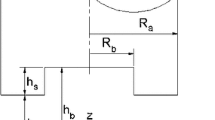Abstract
This paper aims to analyze the effect of transverse surface roughness on the performance of squeeze film in parallel circular disks with non-Newtonian ferrofluid under the presence of transverse magnetic field. The modified Reynolds’ equation obtained by applying the Shliomis ferrohydrodynamic model incorporating the Stokes micro-continuum theory, has been stochastically averaged taking recourse to Christensen and Tonder’s model for transverse roughness. With the aid of suitable boundary conditions the equation has been solved to derive the expression for the pressure distribution, thus resulting in the calculation of load carrying capacity. The results establish that the transverse surface roughness significantly affects the squeeze film performance. This article offers some measures to compensate the adverse effect of roughness under suitable conditions due to the positive effect of non-Newtonian ferrofluid.
Access provided by Autonomous University of Puebla. Download conference paper PDF
Similar content being viewed by others
Keywords
1 Introduction
It is well established that ferrofluids can be retained at a desired location by the application of an external magnetic field. Because of this advantage ferrofluids are widely applicable. In some of the investigations one comes across the application of ferrofluid as a lubricant to analyze the squeeze film performance characteristics of thin film lubricating mechanism [1–5]. Because of the fact that the viscosity of ferrofluid increases when subjected to external magnetic fields, the magnetic fluid lubricated squeeze film results in a higher load carrying capacity as compared to the conventional lubricants. Patel et al. [6] studied the performance of magnetic fluid based rotating rough circular step bearing. Here it was shown that the magnetic fluid went a long way in mitigating the negative effect of transverse surface roughness. Recently, Lin et al. [7] considered the squeeze film performance in parallel circular disks lubricated by ferrofluids with non-Newtonian couple stresses. Here, it has been sought to investigate the effect of transverse roughness on the configuration of Lin et al. [7].
1.1 Analysis
The stochastically averaged [8–10] modified Reynolds’ equation governing the pressure distribution for the performance of ferrofluid lubricated squeeze film in circular disk with non-Newtonian couple stress is found to be [7]
where
Solving this equation with the boundary conditions
(1) \( r = 0 \), \( \frac{dp}{dr} = 0 \) and (2) \( r = R \), \( p = 0 \) the expression for non dimensional pressure distribution is obtained as
Integrating the film pressure over the film region, yields the load carrying capacity
It is clearly seen that the results of Lin et al. [7] can be obtained from this study by setting the roughness parameters to be zero. For the quantitative analysis the Figs. 1, 2, 3, 4, 5 and 6 are taken into consideration.
2 Conclusions
The following conclusions can be drawn from the graphical representation.
-
(1)
Out of the three roughness parameters, it is the skewness which holds the key for an improved performance as the load carrying capacity increases sharply due to negatively skewed roughness, even the variance (-ve) increases the load carrying capacity.
-
(2)
The standard deviation affects the systems adversely, though in most of the situation the effect is not that significant.
-
(3)
The positive effect induced by negative skewness further enhances when variance (-ve) occurs.
-
(4)
In some circumstances, Shliomis model scores over the Newringer Rosenwicz model.
-
(5)
This investigation strongly suggests that the roughness aspects must be accorded priority while designing the bearing system, even if suitable magnetic strength is in place.
References
Tipei N (1982) Theory of lubrication with ferrofluids: application of short bearings. J Lub Tech—Trans ASME 104:510–515
Zhang Y (1991) Static characteristics of magnetized journal bearing lubricated with ferrofluid. J Tribol—Trans ASME 113:533–538
Ahmed N, Singh JP (2007) Magnetic fluid lubrication of porous-pivoted slider bearing with slip velocity. Proc Inst Mech Eng J—J Eng Tribol 221:609–613
Deheri GM, Patel HC, Patel RM (2006) Performance of magnetic fluid based circular step bearing. Mechanika 1:22–27
Shimpi ME, Deheri GM (2012) A study on the performance of a magnetic fluid based squeeze film in curved porous rotating rough annular plates and deformation effect. Tribol Int 47:90–99
Patel HC, Deheri GM, Patel RM (2008) Performance of magnetic fluid based rotating rough circular step bearing. Int J Appl Mech Eng 13(2):441–455
Lin JR, Lu RF, Lin MC, Wang PY (2013) Squeeze film characteristics of parallel circular disks lubricated by ferrofluids with non-Newtonian couple stresses. Tribol Int 61:56–61
Christensen H, Tonder KC (1969a) Tribology of rough surfaces: stochastic models of hydrodynamic lubrication. SINTEF Report No.10/69-18
Christensen H, Tonder KC (1969b) Tribology of rough surfaces: parametric study and comparison of lubrication models. SINTEF Report No.22/69-18
Christensen H, Tonder KC (1970) The hydrodynamic lubrication of rough bearing surfaces of finite width. In: ASME-ASLE lubrication conference. Paper No.70-Lub-7
Author information
Authors and Affiliations
Corresponding author
Editor information
Editors and Affiliations
Rights and permissions
Copyright information
© 2014 Springer India
About this paper
Cite this paper
Patel, H.A., Patel, M.P., Patel, H.C., Deheri, G.M. (2014). Squeeze Film Performance in Parallel Rough Circular Disks Lubricated by Ferrofluid with Non-newtonian Couple Stress Effect. In: Patel, H., Deheri, G., Patel, H., Mehta, S. (eds) Proceedings of International Conference on Advances in Tribology and Engineering Systems. Lecture Notes in Mechanical Engineering. Springer, New Delhi. https://doi.org/10.1007/978-81-322-1656-8_9
Download citation
DOI: https://doi.org/10.1007/978-81-322-1656-8_9
Published:
Publisher Name: Springer, New Delhi
Print ISBN: 978-81-322-1655-1
Online ISBN: 978-81-322-1656-8
eBook Packages: EngineeringEngineering (R0)










